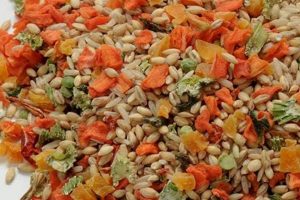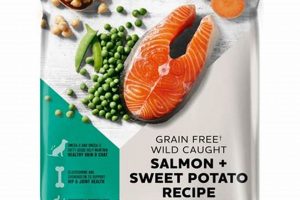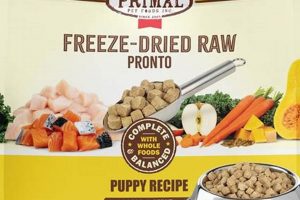A specialized canine diet formulated to assist in achieving and maintaining a healthy body composition for dogs. These products typically feature a carefully balanced nutrient profile, emphasizing lower calorie density and increased fiber content. This formulation supports satiety, facilitating reduced food intake without sacrificing essential nutritional requirements. A common example includes dry kibble designed for overweight or less active dogs.
The significance of this category lies in addressing the rising prevalence of canine obesity and its associated health risks. Maintaining an optimal weight contributes to improved joint health, cardiovascular function, and overall longevity. Historically, managing a dog’s weight required precise portion control and potentially restrictive feeding practices. Modern weight management options offer a more convenient and nutritionally complete solution.
The following discussion will delve into the specific ingredients, nutritional considerations, and practical applications of diets designed to promote a healthy weight in dogs. Further topics will explore factors to consider when selecting the right option, and how to implement it effectively as part of a comprehensive weight management strategy.
Guidance for Optimal Results
The following recommendations aim to maximize the effectiveness of dietary interventions for canine weight management, ensuring both safety and improved health outcomes.
Tip 1: Gradual Transition: Introduce the new diet incrementally over a period of 7-10 days. This minimizes digestive upset and allows the dog to adjust to the altered fiber content and caloric density. Begin by substituting a small portion of the current food with the new formula, gradually increasing the ratio until the transition is complete.
Tip 2: Precise Measurement: Adhere strictly to the feeding guidelines provided on the product packaging. Utilize a calibrated measuring cup to ensure accurate portion sizes. Avoid estimation, as even small discrepancies can undermine weight loss efforts.
Tip 3: Controlled Feeding Schedule: Establish a consistent feeding schedule, offering meals at the same times each day. This aids in regulating appetite and preventing opportunistic overeating. Divide the daily ration into multiple smaller meals to further promote satiety.
Tip 4: Limited Treats and Supplements: Minimize the provision of supplementary treats, chews, and table scraps. These additions contribute unnecessary calories and can negate the effects of the controlled diet. If treats are unavoidable, opt for low-calorie alternatives and factor them into the daily caloric allowance.
Tip 5: Regular Exercise: Integrate regular physical activity into the dog’s routine. Exercise increases caloric expenditure, promotes muscle mass development, and contributes to overall well-being. Consult with a veterinarian to determine an appropriate exercise regimen based on the dog’s age, breed, and physical condition.
Tip 6: Monitor Body Condition: Regularly assess the dog’s body condition score (BCS). BCS is a standardized method for evaluating body fat percentage. Adjust feeding amounts based on changes in BCS, aiming for a gradual and sustainable weight loss.
The consistent application of these guidelines facilitates successful weight management and enhances the overall health and vitality of the canine companion.
The subsequent section will address potential challenges and troubleshooting strategies in the implementation of a weight management diet.
1. Calorie Restriction
Calorie restriction is a fundamental component of weight management strategies for canines. In the context of specialized dietary formulations, it represents a calculated reduction in energy density designed to induce weight loss without compromising essential nutritional intake. The objective is to create a caloric deficit, compelling the body to utilize stored fat reserves for energy.
- Precise Caloric Control
Formulations often employ precise caloric control, reducing energy density per unit weight compared to standard maintenance diets. This is achieved through careful ingredient selection and portion adjustments, ensuring each serving delivers fewer calories while maintaining adequate levels of protein, vitamins, and minerals. An example involves reducing the fat content while increasing fiber to maintain satiety and nutritional adequacy at a lower caloric intake.
- Ingredient Selection and Impact
The selection of ingredients plays a critical role in achieving effective calorie restriction. Fiber-rich components like cellulose or beet pulp contribute to feelings of fullness, reducing the likelihood of overconsumption. Lean protein sources, such as poultry or fish, support muscle mass preservation during weight loss. Conversely, high-fat ingredients are minimized to reduce the overall energy density. The strategic use of these ingredients impacts the food’s caloric profile and its ability to promote weight loss.
- Individualized Feeding Regimens
Implementing a calorie-restricted diet requires individualized feeding regimens based on the dog’s specific metabolic needs, activity level, and breed characteristics. Veterinary professionals often recommend calculating the Resting Energy Requirement (RER) and adjusting it based on factors like activity level to determine the appropriate daily caloric intake. These calculations guide precise portion control and prevent excessive or insufficient calorie restriction, ensuring safe and effective weight loss.
- Monitoring and Adjustments
Regular monitoring of body condition and weight is essential for successful calorie restriction. Veterinary check-ups and consistent weight monitoring help track progress and identify potential issues. Adjustments to the feeding regimen may be necessary if weight loss is too rapid, too slow, or if the dog exhibits signs of nutrient deficiencies. This adaptive approach ensures the dietary intervention remains tailored to the dog’s evolving needs.
These facets of calorie restriction, when integrated into a weight management strategy using specialized dietary options, can effectively support canine weight loss. Continuous monitoring, individual adjustments, and adherence to veterinary recommendations are critical for success. Dietary formulations designed for weight management leverage ingredient selection, controlled energy density, and tailored feeding guidelines to address canine obesity.
2. Fiber Enrichment
Fiber enrichment is a pivotal element in the formulation of specialized diets intended for canine weight management. The incorporation of increased fiber levels serves specific physiological purposes relevant to weight reduction and maintenance, influencing satiety, digestive transit, and overall metabolic function. Fiber’s role extends beyond simply adding bulk; it actively contributes to the effectiveness of such dietary interventions.
- Satiety Enhancement
Fiber, particularly insoluble types, increases digesta volume in the gastrointestinal tract, promoting a feeling of fullness. This heightened satiety reduces the perception of hunger, mitigating the urge to overeat or seek supplemental food sources. For example, formulations often include beet pulp or cellulose, which expand in the stomach, signaling satiety to the brain and consequently limiting caloric intake. This satiety-inducing effect is particularly crucial in weight management regimens.
- Digestive Transit Regulation
Fiber influences the rate at which food moves through the digestive system. Moderate fiber levels can improve digestive regularity and prevent constipation, a common concern in calorie-restricted diets. Different fiber types exert varying effects on transit time; soluble fibers can slow gastric emptying, further contributing to satiety, while insoluble fibers add bulk and accelerate colonic transit. This balance is carefully considered in the formulation to optimize digestive health.
- Caloric Dilution
Fiber itself provides negligible caloric value. By increasing the proportion of fiber in a diet, the overall caloric density is reduced without sacrificing food volume. This enables the dog to consume a satisfying portion size while still achieving a caloric deficit. This caloric dilution is often achieved by substituting a portion of higher-calorie ingredients, such as fats, with fiber sources. This dilution strategy permits controlled weight loss while maintaining a sense of fullness and satisfaction.
- Glycemic Control
Soluble fiber types can influence the rate of glucose absorption from the intestines, potentially mitigating postprandial hyperglycemia. This modulation can be particularly beneficial for overweight dogs, which may exhibit impaired glucose tolerance. The inclusion of soluble fibers may help to stabilize blood sugar levels, reducing insulin spikes and promoting more efficient fat metabolism. This aspect of fiber enrichment can contribute to improved metabolic health beyond simple weight reduction.
The strategic use of fiber enrichment, therefore, directly supports the efficacy of weight management diets. By promoting satiety, regulating digestive transit, diluting caloric density, and potentially influencing glycemic control, fiber becomes a crucial tool in achieving and maintaining a healthy body weight. Its role is multifaceted, extending beyond mere bulk to actively contribute to various physiological processes pertinent to weight management and overall health.
3. Protein Maintenance
The preservation of lean muscle mass is a critical consideration during canine weight management, directly influencing metabolic rate and overall health outcomes. Diets designed for weight reduction, exemplified by specialized “nutrisource weight management dog food” formulations, must prioritize adequate protein intake to counteract the catabolic effects of caloric restriction. Insufficient protein consumption during weight loss can result in the breakdown of muscle tissue, leading to a decrease in metabolic rate, thereby hindering long-term weight management success. For instance, a dog consuming a calorie-restricted diet lacking sufficient protein may initially lose weight but ultimately experience a reduced capacity to burn calories, making subsequent weight maintenance challenging.
Formulations typically include higher protein percentages compared to standard maintenance diets to mitigate muscle loss. Protein sources are often selected for their high biological value, ensuring efficient utilization by the body. The increased protein helps preserve satiety, contributing to reduced food intake. Examples include chicken, fish, or egg-based protein ingredients. These protein sources provide essential amino acids necessary for muscle repair and maintenance. Without adequate protein from this diet, even moderate exercise can contribute to muscle breakdown, counteracting weight management efforts.
Therefore, in the context of “nutrisource weight management dog food”, protein maintenance is not merely a supplementary concern but a fundamental principle dictating the diet’s efficacy. The specific quantity and quality of protein are critical parameters. Overly restrictive protein levels can compromise muscle mass, while excessive protein may contribute to unnecessary caloric intake. The objective is a balanced approach that prioritizes lean muscle preservation, optimizes metabolic function, and supports sustained weight loss, without neglecting essential elements of fiber enrichment and calorie restriction, to promote long-term health.
4. Nutrient Balance
Canine weight management necessitates a careful consideration of nutrient balance, particularly when employing specialized diets. These formulas, designed for calorie restriction and weight loss, risk creating nutritional deficiencies if not meticulously crafted. The concept of nutrient balance within this context refers to providing all essential vitamins, minerals, and fatty acids in appropriate ratios relative to the reduced caloric intake. Simply reducing food volume without adjusting nutrient density can lead to suboptimal health outcomes. For example, a diet deficient in essential fatty acids might result in skin and coat issues, even as the dog achieves a desired weight.
The correlation to specialized diet formulas is direct and causal. These products are engineered to deliver a complete and balanced nutritional profile despite a reduced caloric load. This typically involves increasing the concentration of key nutrients to compensate for the smaller serving sizes. Ingredients are selected not only for their low-calorie content and fiber contribution but also for their inherent nutritional value. For instance, the inclusion of fish oil provides omega-3 fatty acids, while added vitamins and minerals ensure that the dog’s needs are met even when consuming fewer calories.
Failure to maintain nutrient balance undermines the entire purpose of weight management. A dog experiencing nutritional deficiencies may exhibit reduced energy levels, compromised immune function, and increased susceptibility to illness. Therefore, it must be formulated to prioritize comprehensive nutrition, mitigating the potential for adverse effects. This balanced nutritional approach supports the safe and effective achievement of weight loss goals, simultaneously contributing to overall health and well-being in the process.
5. Palatability
Palatability constitutes a critical factor in the successful implementation of any dietary intervention, particularly when addressing canine weight management. Its influence extends beyond mere acceptance of the food; it significantly impacts adherence to the prescribed feeding regimen and, consequently, the overall effectiveness of the weight loss program.
- Ingredient Selection and Formulation
The choice of ingredients and their relative proportions profoundly influence palatability. Formulations often incorporate meat-based flavors or appealing textures to enhance acceptance. However, the constraints of calorie restriction and nutrient balancing necessitate careful selection. For instance, while high-fat ingredients are often palatable, their inclusion must be limited to maintain a lower caloric density. The final formulation is the result of balancing nutritional requirements with taste preferences.
- Aroma and Texture Considerations
Aroma and texture contribute significantly to a dog’s perception of food. Pleasant aromas can stimulate appetite, while desirable textures can enhance the eating experience. Weight management options may utilize techniques such as kibble shape and coating to optimize these sensory attributes. The consideration of texture is crucial as it impacts a dogs enjoyment of the product.
- Overcoming Aversion to Dietary Changes
Introducing a new diet can be challenging, as dogs may exhibit neophobia or aversion to unfamiliar foods. Gradual transitions and the inclusion of flavor enhancers can help overcome this resistance. Mixing the new diet with the old one, slowly increasing the ratio over time, can improve acceptance. Supplementation with flavor additives may also be necessary in some cases, where gradual changes are ineffective.
- Long-Term Adherence and Diet Fatigue
Maintaining long-term adherence to a weight management diet requires sustained palatability. Dogs may experience diet fatigue if the food becomes monotonous or unappetizing over time. Varying the flavor or texture, if feasible within the constraints of the formulation, can help prevent this phenomenon. Rotating between different flavor profiles could support sustained interest, contributing to long-term diet adherence.
Ultimately, the success of “nutrisource weight management dog food” hinges, in part, on its ability to appeal to the target canine population. A palatable option ensures consistent consumption, thereby facilitating the achievement of weight loss goals and supporting overall health. The long-term effectiveness of these diets relies on the dogs continued acceptance of the food, without which, the diet is not useful for the dog.
Frequently Asked Questions About Nutrisource Weight Management Dog Food
The following section addresses common inquiries and concerns regarding the use of a specific dietary approach for canine weight management. These questions are answered with factual information to promote informed decision-making.
Question 1: Is it safe to switch my dog to weight management food abruptly?
An abrupt dietary change can disrupt the canine digestive system, potentially leading to gastrointestinal upset. A gradual transition over 7-10 days is recommended. This allows the dog’s gut microbiota to adapt to the new food composition, minimizing digestive disturbances.
Question 2: How much should my dog be fed with a Nutrisource Weight Management Dog Food?
Feeding guidelines provided on the product packaging serve as a starting point. However, individual caloric needs vary based on factors such as age, activity level, and breed. Consulting a veterinarian to determine the appropriate daily caloric intake is advisable.
Question 3: What if my dog does not like the taste of the weight management food?
Palatability can be a challenge. A gradual introduction, mixing the weight management option with the current food, can improve acceptance. If the dog remains resistant, alternative weight management formulations or flavor enhancers may be considered.
Question 4: Can treats be given while the dog is on a weight management diet?
Treats can compromise the effectiveness of the diet due to added calories. If treats are unavoidable, select low-calorie options and factor their caloric content into the daily allowance. Alternatives, such as carrot sticks or small pieces of cooked chicken, can serve as healthy substitutes.
Question 5: How long will it take for my dog to lose weight on this diet?
Weight loss timelines vary depending on individual factors. A gradual and sustainable weight loss of 1-2% of body weight per week is generally considered a healthy rate. Regular monitoring of body condition and weight is essential to track progress.
Question 6: Is exercise necessary in addition to a weight management diet?
Exercise is an integral component of a comprehensive weight management strategy. Physical activity increases caloric expenditure, promotes muscle mass development, and contributes to overall well-being. A veterinarian can recommend an appropriate exercise regimen based on the dog’s individual needs and limitations.
Key takeaways emphasize the importance of gradual transitions, precise feeding amounts, controlled treat administration, and the integration of exercise. The effectiveness of a weight management approach relies on consistent application of these principles.
The following segment addresses potential challenges and troubleshooting strategies when implementing a dietary weight management regimen.
Conclusion
The preceding exploration of “nutrisource weight management dog food” has illuminated various facets of its formulation and application. Key aspects include calorie restriction, fiber enrichment, protein maintenance, nutrient balance, and palatability. The interplay of these factors directly influences the diet’s effectiveness in achieving and sustaining healthy canine weight management. Proper implementation necessitates individualized feeding regimens, regular monitoring, and veterinary consultation.
Effective weight management significantly contributes to improved canine health and longevity. The responsible and informed use of options, coupled with a comprehensive lifestyle approach, empowers owners to proactively address canine obesity and its associated health risks. Continued vigilance and adherence to professional veterinary guidance are paramount for optimizing long-term well-being.







